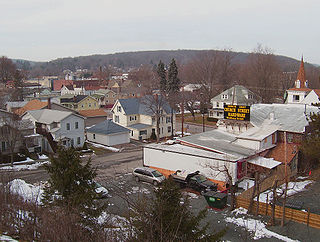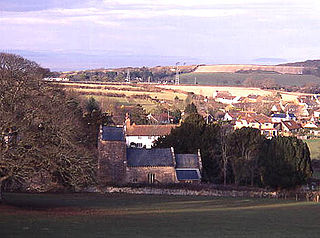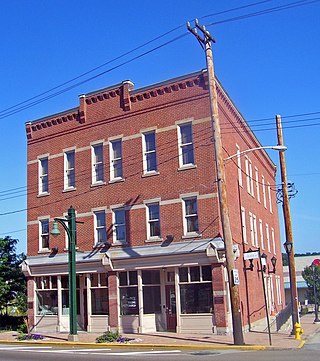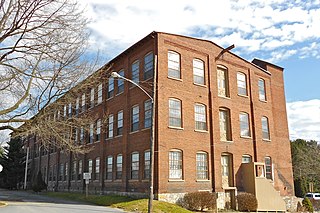
Hawley is a borough on the Lackawaxen River in Wayne County, Pennsylvania, United States. The borough's population was 1,229 at the time of the 2020 United States Census.

Hŭich'ŏn is a city in the southern part of Chagang Province, North Korea. The population is 168,180.

The A.H. Heisey Company was formed in Newark, Ohio, in 1895 by A.H. Heisey. The factory provided fine quality glass tableware and decorative glass figurines. Both pressed and blown glassware were made in a wide variety of patterns and colors. The company also made glass automobile headlights and Holophane Glassware lighting fixtures. The company was operated by Heisey and his sons until 1957, when the factory closed.

Holford is a village and civil parish in West Somerset within the Quantock Hills Area of Outstanding Natural Beauty. It is located about 10 miles (16 km) west of Bridgwater and 6 miles (10 km) east of Williton, with a population of 392. The village is on the Quantock Greenway and Coleridge Way footpaths. The parish includes the village of Dodington.

The Bost Building, also known as Columbia Hotel, is located on East Eighth Avenue in Homestead, Pennsylvania, United States. Built just before the 1892 Homestead Strike, it was used as headquarters by the Amalgamated Association of Iron and Steel Workers and for reporters covering the confrontation. It is the only significant building associated with the strike that remains intact. It is a contributing property to the Homestead Historic District. It was declared a National Historic Landmark in 1999.

Filene's Department Store was a department store building at 426 Washington Street in Downtown Crossing, Boston, Massachusetts. It was the flagship store of the Filene's department store chain. The building has been renovated and now serves as the offices for Havas and Arnold Worldwide. The building is maintained as part of the Millennium Tower. It is now home to fast fashion retailer, Primark.

White Mills is a village and census-designated place that is located in Texas Township, Wayne County, Pennsylvania, United States. The CDP's population was 659 at the time of the 2010 United States Census.

A silk mill is a factory that makes silk for garments using a process called silk throwing. Traditionally, silk mills were concentrated in Japan, England, New Jersey, Pennsylvania, Italy and Switzerland.

The Armstrong Cork Company was a cork manufacturer which was located at 2349 Railroad Street in the Strip District neighborhood of Pittsburgh, Pennsylvania.

The Lehigh Valley Silk Mills were a collection of mills located in the Lehigh Valley region of eastern Pennsylvania in the 19th and 20th centuries.

The Rich-McCormick Woolen Factory is an historic, American woolen mill that is located in Dunnstable Township in Clinton County, Pennsylvania.

The Ashley and Bailey Company Silk Mill, also known as the Franklin Silk Mill and Leinhardt Brothers Furniture Warehouse, is an historic silk mill which is located in West York, York County, Pennsylvania. It was added to the National Register of Historic Places (NRHP) in 1991 as an example of vernacular industrial architecture.

The Ashley and Bailey Silk Mill is an historic silk mill which is located in Marietta, Lancaster County, Pennsylvania. It was listed on the National Register of Historic Places in 1980.

Eugene Dorflinger Estate is a historic home and estate located at Texas Township, Wayne County, Pennsylvania. The house was built in 1865, and is a two-story, wood-frame dwelling with Victorian gingerbread trim. Also on the property are the contributing museum building, carriage house, photography studio, wash house, outhouse, and gazebo. The buildings are what is remaining from the Dorflinger Glass Works.

Bellemonte Silk Mill, also known as Welwood Silk Mill and Sherman Underwear Mills, is a historic mill located at Hawley, Wayne County, Pennsylvania. It was built in 1880-1881, and rebuilt in 1894 after a fire. It is a three- to five-story, long and narrow bluestone building in a High Victorian Gothic style. It features a castellated roof parapet. It has a one-story, shed roofed engine house addition. The mill is locally considered to be the largest bluestone building in the world. The property also includes the contributing Cocoon House; a one-story, one room stone building. In 2011 the Bellemonte Silk Mill and Cocoon House were renovated by Peter Bohlin. The Bellemonte Silk Mill became the Hawley Silk Mill and the Cocoon House became Cocoon Coffee House. The building once housed an antique resale shop.

The Grimshaw Silk Mill, also known as Freeman Shoes, is an historic factory building which is located in Reading, Berks County, Pennsylvania.
O'Connor Building may refer to:
Seneca Glass Company was a glass manufacturer that began in Fostoria, Ohio, in 1891. At one time it was the largest manufacturer of blown tumblers in the United States. The company was also known for its high-quality lead (crystal) stemware, which was hand-made for nearly a century. Customers included Eleanor Roosevelt and Lyndon B. Johnson, and retailers such as Marshall Field and Company, Neiman Marcus, and Tiffany's.

Spring Mill is an unincorporated community in Whitemarsh Township, Montgomery County, Pennsylvania, United States.
Indiana Glass Company was an American company that manufactured pressed, blown and hand-molded glassware and tableware for almost 100 years. Predecessors to the company began operations in Dunkirk, Indiana, in 1896 and 1904, when East Central Indiana experienced the Indiana gas boom. The company started in 1907, when a group of investors led by Frank W. Merry formed a company to buy the Dunkirk glass plant that belonged to the bankrupt National Glass Company. National Glass was a trust for glass tableware that originally owned 19 glass factories including the plant in Dunkirk. National Glass went bankrupt in 1907, and its assets were sold in late 1908.






















